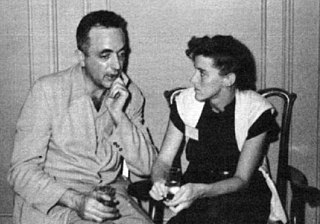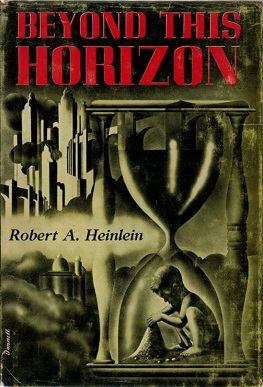
Beyond This Horizon is a science fiction novel by American writer Robert A. Heinlein. It was originally published as a two-part serial in Astounding Science Fiction and then as a single volume by Fantasy Press in 1948. It was awarded a Retro-Hugo award for best novel in 2018.

Alfred Bester was an American science fiction author, TV and radio scriptwriter, magazine editor and scripter for comic strips and comic books. He is best remembered for his science fiction, including The Demolished Man, winner of the inaugural Hugo Award in 1953.
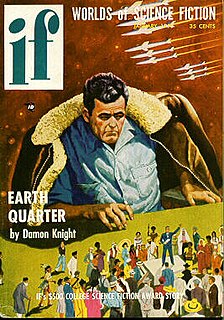
Damon Francis Knight was an American science fiction author, editor and critic. He is the author of "To Serve Man", a 1950 short story adapted for The Twilight Zone. He was married to fellow writer Kate Wilhelm.

Galaxy Science Fiction was an American digest-size science fiction magazine, published from 1950 to 1980. It was founded by a French-Italian company, World Editions, which was looking to break into the American market. World Editions hired as editor H. L. Gold, who rapidly made Galaxy the leading science fiction (sf) magazine of its time, focusing on stories about social issues rather than technology.

Algirdas Jonas "Algis" Budrys was a Lithuanian-American science fiction author, editor, and critic. He was also known under the pen names Frank Mason, Alger Rome, John A. Sentry, William Scarff, and Paul Janvier.

Robert Silverberg is an American author and editor, best known for writing science fiction. He is a multiple winner of both Hugo and Nebula Awards, a member of the Science Fiction and Fantasy Hall of Fame, and a Grand Master of SF. He has attended every Hugo Awards ceremony since the inaugural event in 1953.
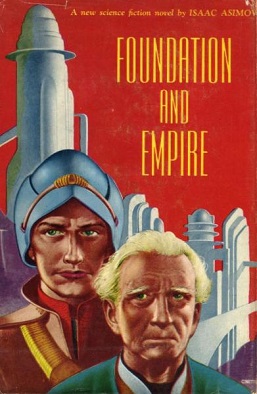
Foundation and Empire is a science fiction novel by American writer Isaac Asimov originally published by Gnome Press in 1952. It is the second book in the Foundation Series, and the fourth in the in-universe chronology. It takes place in two parts, originally published as separate novellas. The second part, "The Mule", won a Retro Hugo Award in 1996.
"Robbie" is a science fiction short story by American writer Isaac Asimov. It was his first robot story and writing commenced on June 10, 1939. It was first published in the September 1940 issue Super Science Stories magazine as "Strange Playfellow", a title that was chosen by editor Frederik Pohl and described as "distasteful" by Asimov. A revised version of Robbie was reprinted under Asimov's original title in the collections I, Robot (1950), The Complete Robot (1982), and Robot Visions (1990). "Robbie" was the fourteenth story written by Asimov, and the ninth to be published. The story is also part of Asimov's Robot series, and was the first of Asimov's positronic robot stories to see publication.

More Than Human is a 1953 science fiction novel by American writer Theodore Sturgeon. It is a revision and expansion of his previously published novella Baby is Three, which is bracketed by two additional parts written for the novel . It won the 1954 International Fantasy Award, which was also given to works in science fiction. It was additionally nominated in 2004 for a "Retro Hugo" award for the year 1954. Science fiction critic and editor David Pringle included it in his book Science Fiction: The 100 Best Novels.

Cities in Flight is a four-volume series of science fiction stories by American writer James Blish, originally published between 1950 and 1962, which were first known collectively as the "Okie" novels. The series features entire cities that are able to fly through space using an anti-gravity device, the spindizzy. The stories cover roughly two thousand years, from the very near future to the end of the universe. One story, "Earthman, Come Home" won a Retro Hugo Award in 2004 for Best Novelette. Since 1970, the primary edition has been the omnibus volume first published in paperback by Avon Books. Over the years James Blish made many changes to these stories in response to points raised in letters from readers.

Three Hearts and Three Lions is a 1961 fantasy novel by American writer Poul Anderson, expanded from a 1953 novella by Anderson which appeared in Fantasy & Science Fiction.
Phyllis Eisenstein is an American author of science fiction and fantasy short stories and novels whose work has been nominated for both the Hugo Award and Nebula Award.

Science-Fiction Handbook, subtitled The Writing of Imaginative Fiction, is a guide to writing and marketing science fiction and fantasy by L. Sprague de Camp, "one of the earliest books about modern sf." The original edition was published in hardcover by Hermitage House in 1953 as a volume in its Professional Writers Library series. A revised edition, by L. Sprague de Camp and Catherine Crook de Camp, titled Science Fiction Handbook, Revised, was published in hardcover by Owlswick Press in 1975 and as a trade paperback by McGraw-Hill in 1977. An E-book version of the revised edition was published by Gollancz's SF Gateway imprint on April 30, 2014.
"Born of Man and Woman" is a science fiction short story by American writer Richard Matheson, originally published in the July 1950 issue of The Magazine of Fantasy and Science Fiction. It was his first professional sale, written when he was twenty-two years old. It became the title piece in Matheson's first short story collection in 1954.
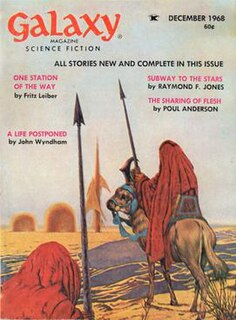
"The Sharing of Flesh" is a science fiction novelette by American writer Poul Anderson. Originally published in Galaxy Science Fiction, it won a 1968 Hugo Award for Best Novelette and was nominated for a 1969 Nebula Award. The story has appeared in the collections The Night Face & Other Stories (1979), The Dark Between the Stars (1981), Winners (1981), and The Long Night (1983).
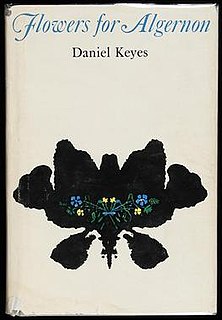
Flowers for Algernon is the title of a science fiction short story and a novel by American writer Daniel Keyes. The short story, written in 1958 and first published in the April 1959 issue of The Magazine of Fantasy & Science Fiction, won the Hugo Award for Best Short Story in 1960. The novel was published in 1966 and was joint winner of that year's Nebula Award for Best Novel.

To the Stars is a science fiction novel by American writer L. Ron Hubbard. The novel's story is set in a dystopian future, and chronicles the experiences of protagonist Alan Corday aboard a starship called the Hound of Heaven as he copes with the travails of time dilation from traveling at near light speed. Corday is kidnapped by the ship's captain and forced to become a member of their crew, and when he next returns to Earth his fiancee has aged and barely remembers him. He becomes accustomed to life aboard the ship, and when the captain dies Corday assumes command.
"Slow Sculpture" is a science fiction short story by American writer Theodore Sturgeon. First published in the Galaxy Science Fiction issue of February 1970, it won the 1970 Nebula Award for Best Novelette and the 1971 Hugo Award for Best Short Story.
'Pauline Whitby was British science fiction author who wrote under the pseudonym Pauline Ashwell (1928 - 23 November 2015. She has also written under the names Paul Ashwell and Paul Ash.
Myrtle Rebecca Douglas Smith Gray Nolan, known to science fiction history as Morojo or sometimes Myrtle R. Douglas, was a science fiction fan, fanzine publisher, and cosplay pioneer from Los Angeles, California.



